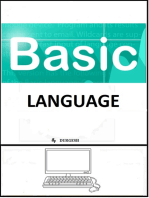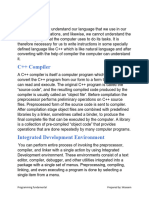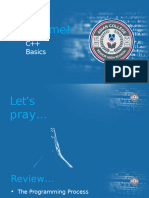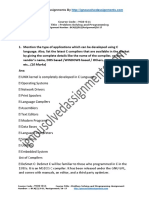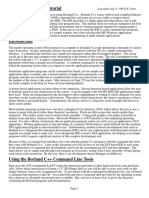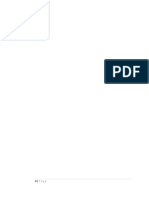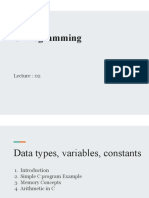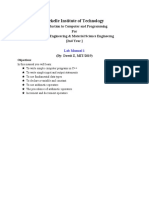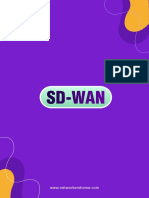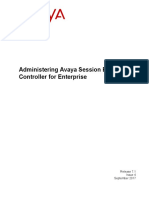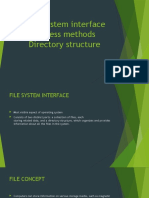Device and Character Input/Output: Example
Device and Character Input/Output: Example
Uploaded by
Aaron BrownCopyright:
Available Formats
Device and Character Input/Output: Example
Device and Character Input/Output: Example
Uploaded by
Aaron BrownOriginal Description:
Original Title
Copyright
Available Formats
Share this document
Did you find this document useful?
Is this content inappropriate?
Copyright:
Available Formats
Device and Character Input/Output: Example
Device and Character Input/Output: Example
Uploaded by
Aaron BrownCopyright:
Available Formats
431
EXAMPLE
C+ + By
21
Devic e and
Charac ter
Input/Output
Unlike many programming languages, C++ contains no input or
output commands. C++ is an extremely portable language; a C++
program that compiles and runs on one computer is able also to
compile and run on another type of computer. Most incompatibili-
ties between computers reside in their input/output mechanics.
Each different device requires a different method of performing
I/O (Input/Output).
By putting all I/O capabilities in common functions supplied
with each computers compiler, not in C++ statements, the design-
ers of C++ ensured that programs were not tied to specific hardware
for input and output. A compiler has to be modified for every
computer for which it is written. This ensures the compiler works
with the specific computer and its devices. The compiler writers
write I/O functions for each machine; when your C++ program
writes a character to the screen, it works the same whether you have
a color PC screen or a UNIX X/Windows terminal.
This chapter shows you additional ways to perform input and
output of data besides the ci n and cout functions you have seen
Chapter 21 o D evice and C haracter Input/O utput
432
C++ vi ews i nput and
output from al l
devi ces as streams
of characters.
throughout the book. By providing character-based I/O functions,
C++ gives you the basic I/O functions you need to write powerful
data entry and printing routines.
This chapter introduces you to
o Stream input and output
o Redirecting I/O
o Printing to the printer
o Character I/O functions
o Buffered and nonbuffered I/O
By the time you finish this chapter, you will understand the
fundamental built-in I/O functions available in C++. Performing
character input and output, one character at a time, might sound like
a slow method of I/O. You will soon realize that character I/O
actually enables you to create more powerful I/O functions than ci n
and cout .
Stream and Charac ter I/O
C++ views all input and output as streams of characters.
Whether your program receives input from the keyboard, a disk file,
a modem, or a mouse, C++ only views a stream of characters. C++
does not have to know what type of device is supplying the input;
the operating system handles the device specifics. The designers of
C++ want your programs to operate on characters of data without
regard to the physical method taking place.
This stream I/O means you can use the same functions to
receive input from the keyboard as from the modem. You can use the
same functions to write to a disk file, printer, or screen. Of course,
you have to have some way of routing that stream input or output
to the proper device, but each programs I/O functions works in a
similar manner. Figure 21.1 illustrates this concept.
433
EXAMPLE
C+ + By
Figure 21.1. All I/O consists of streams of characters.
The Newline Special Character: / n
Portability is the key to C++s success. Few companies have the
resources to rewrite every program they use when they change
computer equipment. They need a programming language
that works on many platforms (hardware combinations). C++
achieves true portability better than almost any other program-
ming language.
It is because of portability that C++ uses the generic newline
character, \ n, rather than the specific carriage return and line
feed sequences other languages use. This is why C++ uses the
\ t for tab, as well as the other control characters used in I/O
functions.
If C++ used ASCII code to represent these special characters,
your programs would not be portable. You would write a C++
program on one computer and use a carriage return value such
as 12, but 12 might not be the carriage return value on another
type of computer.
By using newline and the other control characters available in
C++, you ensure your program is compatible with any com-
puter on which it is compiled. The specific compilers substitute
their computers actual codes for the control codes in your
programs.
Chapter 21 o D evice and C haracter Input/O utput
434
Standard Devic es
Table 21.1 shows a listing of standard I/O devices. C++ always
assumes input comes from stdin, meaning the standard input device.
This is usually the keyboard, although you can reroute this default.
C++ assumes all output goes to stdout, or the standard output device.
There is nothing magic in the words stdin and stdout; however,
many people learn their meanings for the first time in C++.
Table 21.1. Standard Devic es in C++.
Description C++ Name MS-DOS Name
Screen stdout CON:
Keyboard stdin CON:
Printer stdprn PRN: or LPT1:
Serial Port stdaux AUX: or COM1:
Error Messages stderr CON:
Disk Files none Filename
Take a moment to study Table 21.1. You might think it is
confusing that three devices are named CON:. MS-DOS differenti-
ates between the screen device called CON: (which stands for
console), and the keyboard device called CON: from the context of
the data stream. If you send an output stream (a stream of characters)
to CON:, MS-DOS routes it to the screen automatically. If you
request input from CON:, MS-DOS retrieves the input from the
keyboard. (These defaults hold true as long as you have not redi-
rected these devices, as shown below.) MS-DOS sends all error
messages to the screen (CON:) as well.
NOTE: If you want to route I/O to a second printer or serial
port, see how to do so in Chapter 30, Sequential Files.
435
EXAMPLE
C+ + By
Redirec ting Devic es from MS-DOS
The reason cout goes to the screen is simply because st dout is
routed to the screen, by default, on most computers. The reason ci n
inputs from the keyboard is because most computers consider the
keyboard to be the standard input device, stdin. After compiling
your program, C++ does not send data to the screen or retrieve it
from the keyboard. Instead, the program sends output to stdout and
receives input from stdin. The operating system routes the data to
the appropriate device.
MS-DOS enables you to reroute I/O from their default loca-
tions to other devices through the use of the output redirection symbol,
>, and the input redirection symbol, <. The goal of this book is not to
delve deeply in operating-system redirection. To learn more about
the handling of I/O, read a good book on MS-DOS, such as Using
MS-DOS 5.
Basically, the output redirection symbol informs the operating
system that you want standard output to go to a device other than
the default (the screen). The input redirection symbol routes input
away from the keyboard to another input device. The following
example illustrates how this is done in MS-DOS.
Examples
1. Suppose you write a program that uses only ci n and cout for
input and output. Instead of receiving input from the key-
board, you want the program to get the input from a file
called MYDATA. Because ci n receives input from st di n, you
must redirect stdin. After compiling the program in a file
called MYPGM.EXE, you can redirect its input away from
the keyboard with the following DOS command:
C: >MYPGM < MYDATA
Of course, you can include a full pathname either before the
program name or filename. There is a danger in redirecting
all output such as this, however. All output, including screen
prompts for keyboard input, goes to MYDATA. This is
probably not acceptable to you in most cases; you still want
The operati ng
system gi ves you
control over devi ces.
Chapter 21 o D evice and C haracter Input/O utput
436
prompts and some messages to go to the screen. In the next
section, you learn how to separate I/O, and send some
output to one device such as the screen and the rest to
another device, such as a file or printer.
2. You can also route the programs output to the printer by
typing this:
C: >MYPGM > PRN:
Route MYPGM output to the printer.
3. If the program required much input, and that input were
stored in a file called ANSWERS, you could override the
keyboard default device that ci n uses, as in:
C: >MYPGM < ANSWERS
The program reads from the file called ANSWERS every time ci n
required input.
4. You can combine redirection symbols. If you want input
from the ANSWERS disk file, and want to send the output to
the printer, do the following:
C: >MYPGM < ANSWERS > PRN:
TIP: You can route the output to a serial printer or a second
parallel printer port by substituting COM1: or LPT2: for PRN:.
Printing Formatted Output to
the Printer
Its easy to send program output to the printer using the
of st r eamfunction. The format of of st r eamis
of st r eamdevi ce( devi ce_name) ;
of st r eamal l ows
your program to
wri te to the pri nter.
437
EXAMPLE
C+ + By
The following examples show how you can combine cout and
of st r eamto write to both the screen and printer.
Example
The following program asks the user for his or her first and last
name. It then prints the name, last name first, to the printer.
/ / Fi l ename: C21FPR1. CPP
/ / Pr i nt s a name on t he pr i nt er .
#i ncl ude <f st r eam. h>
voi d mai n( )
{
char f i r st [ 20] ;
char l ast [ 20] ;
cout << What i s your f i r st name? ;
ci n >> f i r st ;
cout << What i s your l ast name? ;
ci n >> l ast ;
/ / Send names t o t he pr i nt er .
of st r eampr n( PRN) ;
pr n << I n a phone book, your name l ooks l i ke t hi s: \ n;
pr n << l ast << , << f i r st << \ n;
r et ur n;
}
Charac ter I/O Func tions
Because all I/O is actually character I/O, C++ provides many
functions you can use that perform character input and output. The
cout and ci n functions are called formatted I/O functions because they
give you formatting control over your input and output. The cout
and ci n functions are not character I/O functions.
of st r eamuses
the fstream.h header
fi l e.
Chapter 21 o D evice and C haracter Input/O utput
438
Theres nothing wrong with using cout for formatted output,
but ci n has many problems, as you have seen. You will now see how
to write your own character input routines to replace ci n, as well as
use character output functions to prepare you for the upcoming
section in this book on disk files.
The get ( ) and put ( ) Func tions
The most fundamental character I/O functions are get ( ) and
put ( ) . The put ( ) function writes a single character to the standard
output device (the screen if you dont redirect it from your operating
system). The get ( ) function inputs a single character from the
standard input device (the keyboard by default).
The format for get ( ) is
devi ce. get ( char _var ) ;
The get ( ) device can be any standard input device. If you were
receiving character input from the keyboard, you use ci n as the
device. If you initialize your modem and want to receive characters
from it, use of st r eamto open the modem device and read from the
device.
The format of put ( ) is
devi ce. put ( char _val ) ;
The char _val can be a character variable, expression, or con-
stant. You output character data with put ( ) . The device can be any
standard output device. To write a character to your printer, you
open PRN with of st r eam.
Examples
1. The following program asks the user for her or his initials a
character at a time. Notice the program uses both cout and
put ( ) . The cout is still useful for formatted output such as
messages to the user. Writing individual characters is best
achieved with put ( ) .
The program has to call two get ( ) functions for each char-
acter typed. When you answer a get ( ) prompt by typing a
get ( ) and put ( )
i nput and output
characters from and
to any standard
devi ces.
439
EXAMPLE
C+ + By
character followed by an Enter keypress, C++ interprets the
input as a stream of two characters. The get ( ) first receives
the letter you typed, then it has to receive the \ n (newline,
supplied to C++ when you press Enter). There are examples
that follow that fix this double get ( ) problem.
/ / Fi l ename: C21CH1. CPP
/ / I nt r oduces get ( ) and put ( ) .
#i ncl ude <f st r eam. h>
voi d mai n( )
{
char i n_char ; / / Hol ds i ncomi ng i ni t i al .
char f i r st , l ast ; / / Hol ds conver t ed f i r st and l ast i ni t i al .
cout << What i s your f i r st name i ni t i al ? ;
ci n. get ( i n_char ) ; / / Wai t s f or f i r st i ni t i al .
f i r st = i n_char ;
ci n. get ( i n_char ) ; / / I gnor es newl i ne.
cout << What i s your l ast name i ni t i al ? ;
ci n. get ( i n_char ) ; / / Wai t s f or l ast i ni t i al .
l ast = i n_char ;
ci n. get ( i n_char ) ; / / I gnor es newl i ne.
cout << \ nHer e t hey ar e: \ n;
cout . put ( f i r st ) ;
cout . put ( l ast ) ;
r et ur n;
}
Here is the output from this program:
What i s your f i r st name i ni t i al ? G
What i s your l ast name i ni t i al ? P
Her e t hey ar e:
GP
2. You can add carriage returns to space the output better. To
print the two initials on two separate lines, use put ( ) to put a
newline character to cout , as the following program does:
Chapter 21 o D evice and C haracter Input/O utput
440
/ / Fi l ename: C21CH2. CPP
/ / I nt r oduces get ( ) and put ( ) and uses put ( ) t o out put
newl i ne.
#i ncl ude <f st r eam. h>
voi d mai n( )
{
char i n_char ; / / Hol ds i ncomi ng i ni t i al .
char f i r st , l ast ; / / Hol ds conver t ed f i r st and l ast
/ / i ni t i al .
cout << What i s your f i r st name i ni t i al ? ;
ci n. get ( i n_char ) ; / / Wai t s f or f i r st i ni t i al .
f i r st = i n_char ;
ci n. get ( i n_char ) ; / / I gnor es newl i ne.
cout << What i s your l ast name i ni t i al ? ;
ci n. get ( i n_char ) ; / / Wai t s f or l ast i ni t i al .
l ast = i n_char ;
ci n. get ( i n_char ) ; / / I gnor es newl i ne.
cout << \ nHer e t hey ar e: \ n;
cout . put ( f i r st ) ;
cout . put ( \ n ) ;
cout . put ( l ast ) ;
r et ur n;
}
3. It might have been clearer to define the newline character as
a constant. At the top of the program, you have:
const char NEWLI NE= \ n
The put ( ) then reads:
cout . put ( NEWLI NE) ;
Some programmers prefer to define their character formatting
constants and refer to them by name. Its up to you to decide whether
you want to use this method, or whether you want to continue using
the \ n character constant in put ( ) .
The get ( ) function is a buffered input function. As you type
characters, the data does not immediately go to your program,
441
EXAMPLE
C+ + By
rather, it goes to a buffer. The buffer is a section of memory (and has
nothing to do with your PCs type-ahead buffers) managed by C++.
Figure 21.2 shows how this buffered function works. When
your program approaches a get ( ) , the program temporarily waits as
you type the input. The program doesnt view the characters, as
theyre going to the buffer of memory. There is practically no limit
to the size of the buffer; it fills with input until you press Enter. Your
Enter keypress signals the computer to release the buffer to your
program.
Figure 21.2. get ( ) input goes to a buffer. The buffer is released when
you press Enter.
Most PCs accept either buffered or nonbuffered input. The
get ch( ) function shown later in this chapter is nonbuffered. With
get ( ) , all input is buffered. Buffered text affects the timing of your
programs input. Your program receives no characters from a get ( )
until you press Enter. Therefore, if you ask a question such as
Do you want t o see t he r epor t agai n ( Y/ N) ?
and use get ( ) for input, the user can press a Y, but the program does
not receive the input until the user also presses Enter. The Y and
Enter then are sent, one character at a time, to the program where it
processes the input. If you want immediate response to a users
typing (such as the I NKEY$ in BASIC allows), you have to use get ch( ) .
Buffer
Chapter 21 o D evice and C haracter Input/O utput
442
TIP: By using buffered input, the user can type a string of
characters in response to a loop with get ( ) , receive characters,
and correct the input with Backspace before pressing Enter. If
the input were nonbuffered, the Backspace would be another
character of data.
Example
C21CH2.CPP must discard the newline character. It did so by
assigning the input characterfrom get ( ) to an extra variable.
Obviously, the get ( ) returns a value (the character typed). In this
case, its acceptable to ignore the return value by not using the
character returned by get ( ) . You know the user has to press Enter (to
end the input) so its acceptable to discard it with an unused get ( )
function call.
When inputting strings such as names and sentences, ci n only
allows one word to be entered at a time. The following string asks the
user for his or her full name with these two lines:
cout << What ar e your f i r st and l ast names? ;
ci n >> names; / / Recei ve name i n char act er ar r ay names.
The array names only receives the first name; ci n ignores all data
to the right of the first space.
You can build your own input function using get ( ) that doesnt
have a single-word limitation. When you want to receive a string of
characters from the user, such as his or her first and last name, you
can call the get _i n_st r ( ) function shown in the next program.
The mai n( ) function defines an array and prompts the user for
a name. After the prompt, the program calls the get _i n_st r ( ) func-
tion and builds the input array a character at a time using get ( ) . The
function keeps looping, using the whi l e loop, until the user presses
Enter (signaled by the newline character, \ n, to C++) or until the
maximum number of characters are typed. You might want to use
When recei vi ng
characters, you
mi ght have to
di scard the newl i ne
keypress.
443
EXAMPLE
C+ + By
this function in your own programs. Be sure to pass it a character
array and an integer that holds the maximum array size (you dont
want the input string to be longer than the character array that holds
it). When control returns to mai n( ) (or whatever function called
get _i n_st r ( ) ), the array has the users full input, including the
spaces.
/ / Fi l ename: C21I N. CPP
/ / Pr ogr amt hat bui l ds an i nput st r i ng ar r ay usi ng get ( ) .
#i ncl ude <f st r eam. h>
voi d get _i n_st r ( char st r [ ] , i nt l en) ;
const i nt MAX=25; / / Si ze of char act er ar r ay t o be t yped.
voi d mai n( )
{
char i nput _st r [ MAX] ; / / Keyboar d i nput f i l l s t hi s.
cout << What i s your f ul l name? ;
get _i n_st r ( i nput _st r , MAX) ; / / St r i ng f r omkeyboar d
cout << Af t er r et ur n, your name i s << i nput _st r << \ n;
r et ur n;
}
/ / **********************************************************
/ / The f ol l owi ng f unct i on r equi r es a st r i ng and t he maxi mum
/ / l engt h of t he st r i ng be passed t o i t . I t accept s i nput
/ / f r omt he keyboar d, and sends keyboar d i nput i n t he st r i ng.
/ / On r et ur n, t he cal l i ng r out i ne has access t o t he st r i ng.
/ / **********************************************************
voi d get _i n_st r ( char st r [ ] , i nt l en)
{
i nt i = 0; / / i ndex
char i nput _char ; / / char act er t yped
ci n. get ( i nput _char ) ; / / Get next char act er i n st r i ng.
whi l e ( i < ( l en - 1) && ( i nput _char ! = \ n ) )
{
st r [ i ] = i nput _char ; / / Bui l d st r i ng a char act er
Chapter 21 o D evice and C haracter Input/O utput
444
i ++; / / at a t i me.
ci n. get ( i nput _char ) ; / / Recei ve next char act er i n st r i ng.
}
st r [ i ] = \ 0 ; / / Make t he char ar r ay a st r i ng.
r et ur n;
}
NOTE: The loop checks for l en - 1 to save room for the null-
terminating zero at the end of the input string.
The get ch( ) and put ch( ) Func tions
The functions get ch( ) and put ch( ) are slightly different from the
previous character I/O functions. Their format is similar to get ( )
and put ( ) ; they read from the keyboard and write to the screen and
cannot be redirected, even from the operating system. The formats
of get ch( ) and put ch( ) are
i nt _var = get ch( ) ;
and
put ch( i nt _var ) ;
get ch( ) and put ch( ) are not AT&T C++ standard functions, but
they are usually available with most C++ compilers. get ch( ) and
put ch( ) are nonbuffered functions. The put ch( ) character output
function is a mirror-image function to get ch( ) ; it is a nonbuffered
output function. Because almost every output device made, except
for the screen and modem, are inherently buffered, put ch( ) effec-
tively does the same thing as put ( ) .
Another difference in get ch( ) from the other character input
functions is that get ch( ) does not echo the input characters on the
screen as it receives them. When you type characters in response to
get ( ) , you see the characters as you type them (as they are sent to the
buffer). If you want to see characters received by get ch( ) , you must
follow get ch( ) with a put ch( ) . It is handy to echo the characters on the
screen so the user can verify that she or he has typed correctly.
get ch( ) and
put ch( ) offer
nonbuffered i nput
and output that grab
the users characters
i mmedi atel y after the
user types them.
445
EXAMPLE
C+ + By
Some programmers want to make the user press Enter after
answering a prompt or selecting from a menu. They feel the extra
time given with buffered input gives the user more time to decide if
she or he wants to give that answer; the user can press Backspace and
correct the input before pressing Enter.
Other programmers like to grab the users response to a single-
character answer, such as a menu response, and act on it immedi-
ately. They feel that pressing Enter is an added and unneeded
burden for the user so they use get ch( ) . The choice is yours. You
should understand both buffered and nonbuffered input so you can
use both.
TIP: You can also use get che( ) . get che( ) is a nonbuffered input
identical to get ch( ) , except the input characters are echoed
(displayed) to the screen as the user types them. Using get che( )
rather than get ch( ) keeps you from having to call a put ch( ) to
echo the users input to the screen.
Example
The following program shows the get ch( ) and put ch( ) func-
tions. The user is asked to enter five letters. These five letters are
added (by way of a f or loop) to the character array named l et t er s.
As you run this program, notice that the characters are not echoed
to the screen as you type them. Because get ch( ) is unbuffered, the
program actually receives each character, adds it to the array, and
loops again, as you type them. (If this were buffered input, the
program would not loop through the five iterations until you
pressed Enter.)
A second loop prints the five letters using put ch( ) . A third loop
prints the five letters to the printer using put ( ) .
/ / Fi l ename: C21GCH1. CPP
/ / Uses get ch( ) and put ch( ) f or i nput and out put .
#i ncl ude <f st r eam. h>
Characters i nput
wi th get ch( ) are
not echoed to the
screen as the user
types them.
get ch( ) and
put ch( ) use the
coni o.h header fi l e.
Chapter 21 o D evice and C haracter Input/O utput
446
#i ncl ude <coni o. h>
voi d mai n( )
{
i nt ct r ; / / f or l oop count er
char l et t er s[ 5] ; / / Hol ds f i ve i nput char act er s. No
/ / r oomi s needed f or t he nul l zer o
/ / because t hi s ar r ay never wi l l be
/ / t r eat ed as a st r i ng.
cout << Pl ease t ype f i ve l et t er s. . . \ n;
f or ( ct r = 0; ct r < 5; ct r ++)
{
l et t er s[ ct r ] = get ch( ) ; / / Add i nput t o ar r ay.
}
f or ( ct r = 0; ct r < 5; ct r ++) / / Pr i nt t hemt o scr een.
{
put ch( l et t er s[ ct r ] ) ;
}
of st r eampr n( PRN) ;
f or ( ct r = 0; ct r < 5; ct r ++) / / Pr i nt t hemt o pr i nt er .
{
pr n. put ( l et t er s[ ct r ] ) ;
}
r et ur n;
}
When you run this program, do not press Enter after the five
letters. The get ch( ) function does not use the Enter. The loop auto-
matically ends after the fifth letter because of the unbuffered input
and the f or loop.
Review Questions
The answers to the review questions are found in Appendix B.
1. Why are there no input or output commands in C++?
2. True or false: If you use the character I/O functions to send
output to stdout, it always goes to the screen.
447
EXAMPLE
C+ + By
3. What is the difference between get ch( ) and get ( ) ?
4. What function sends formatted output to devices other than
the screen?
5. What are the MS-DOS redirection symbols?
6. What nonstandard function, most similar to get ch( ) , echoes
the input character to the screen as the user types it?
7. True or false: When using get ( ) , the program receives your
input as you type it.
8. Which keypress releases the buffered input to the program?
9. True or false: Using devices and functions described in this
chapter, it is possible to write one program that sends some
output to the screen, some to the printer, and some to the
modem.
Review Exerc ises
1. Write a program that asks the user for five letters and prints
them in reverse order to the screen, and then to the printer.
2. Write a miniature typewriter program, using get ( ) and put ( ) .
In a loop, get characters until the user presses Enter while he
or she is getting a line of user input. Write the line of user
input to the printer. Because get ( ) is buffered, nothing goes
to the printer until the user presses Enter at the end of each
line of text. (Use the string-building input function shown in
C21IN.CPP.)
3. Add a put ch( ) inside the first loop of C21CH1.CPP (this
chapters first get ( ) example program) so the characters are
echoed to the screen as the user types them.
4. A palindrome is a word or phrase spelled the same forwards
and backwards. Two example palindromes are
Madam, I mAdam
Gol f ? No si r , pr ef er pr i son f l og!
Chapter 21 o D evice and C haracter Input/O utput
448
Write a C++ program that asks the user for a phrase. Build
the input, a character at a time, using a character input
function such as get ( ) . Once you have the full string (store it
in a character array), determine whether the phrase is a
palindrome. You have to filter special characters (nonalpha-
betic), storing only alphabetic characters to a second charac-
ter array. You also must convert the characters to uppercase
as you store them. The first palindrome becomes:
MADAMI MADAM
Using one or more f or or whi l e loops, you can now test the
phrase to determine whether it is a palindrome. Print the
result of the test on the printer. Sample output should look
like:
Madam, I mAdam i s a pal i ndr ome.
Summary
You now should understand the generic methods C++ pro-
grams use for input and output. By writing to standard I/O devices,
C++ achieves portability. If you write a program for one computer,
it works on another. If C++ were to write directly to specific
hardware, programs would not work on every computer.
If you still want to use the formatted I/O functions, such as cout ,
you can do so. The of st r eam( ) function enables you to write format-
ted output to any device, including the printer.
The methods of character I/O might seem primitive, and they
are, but they give you the flexibility to build and create your own
input functions. One of the most often-used C++ functions, a string-
building character I/O function, was demonstrated in this chapter
(the C21IN.CPP program).
The next two chapters (Chapter 22, Character, String, and
Numeric Functions, and Chapter 23, Introducing Arrays) intro-
duce many character and string functions, including string I/O
functions. The string I/O functions build on the principles pre-
sented here. You will be surprised at the extensive character and
string manipulation functions available in the language as well.
You might also like
- Avery Dennison ALX924 Labelprinter ParametersDocument141 pagesAvery Dennison ALX924 Labelprinter ParametersKenneth Thoft AndersenNo ratings yet
- Based On: Deitel & Deitel, C++ How To Program, Late Objects Version, 7/eDocument79 pagesBased On: Deitel & Deitel, C++ How To Program, Late Objects Version, 7/eDeez NutsNo ratings yet
- C Programming Notes (R10 I Year I Semester)Document31 pagesC Programming Notes (R10 I Year I Semester)ravikiranteluNo ratings yet
- C++ Lab 1: Required Terminology and General Information For This ChapterDocument12 pagesC++ Lab 1: Required Terminology and General Information For This ChapterN_SpearsNo ratings yet
- BCP Lab ManualDocument65 pagesBCP Lab Manualferoz pathanNo ratings yet
- Programing C++ CH (1-5)Document68 pagesPrograming C++ CH (1-5)احمد الوحشNo ratings yet
- C++ Chapter 1-5Document68 pagesC++ Chapter 1-5qusic8No ratings yet
- Overview of C++ and Sample C++ ProgramDocument10 pagesOverview of C++ and Sample C++ Programatul211988No ratings yet
- 02FundamentalOfCppDocument26 pages02FundamentalOfCppnanigir651No ratings yet
- Input Output in Assembly LanguageDocument23 pagesInput Output in Assembly LanguageThegomez72100% (1)
- STD 8 Notes C++ 2015-16Document13 pagesSTD 8 Notes C++ 2015-16yekomor876No ratings yet
- C++ IntrodDocument8 pagesC++ IntrodHend TalafhaNo ratings yet
- HORIZON 2000 Computer Training Centre C - Getting StartedDocument12 pagesHORIZON 2000 Computer Training Centre C - Getting StartedRoxanne ROxNo ratings yet
- File: Main - CPP Author: A K Created On April 28, 2018 / #IncludeDocument4 pagesFile: Main - CPP Author: A K Created On April 28, 2018 / #IncludeAshfaq KhanNo ratings yet
- chapter2Document6 pageschapter2Daniel GetachewNo ratings yet
- C Quick GuideDocument34 pagesC Quick GuideVignesh Vigi CNo ratings yet
- CPP INTRO. 1Document2 pagesCPP INTRO. 1Daniela PerezNo ratings yet
- 程式設計Cpp Ch02 Mchang 20220923 PDFDocument90 pages程式設計Cpp Ch02 Mchang 20220923 PDFvanness670trashNo ratings yet
- Programming Fundamental Mid TermDocument33 pagesProgramming Fundamental Mid Termaaimaajmal321No ratings yet
- Lesson 4 - C++ BasicsDocument26 pagesLesson 4 - C++ BasicsDaisy Belle BoholNo ratings yet
- Structured Programming With C++ 2Document8 pagesStructured Programming With C++ 2abdulwasiuwaris4No ratings yet
- C Programming Unit 1Document4 pagesC Programming Unit 1Corey Ellis100% (1)
- MCS-011 Problem Solving and Programming AssignmentDocument8 pagesMCS-011 Problem Solving and Programming AssignmentSumit RanjanNo ratings yet
- CPP 1Document7 pagesCPP 1minaleNo ratings yet
- P1 (Programming)Document4 pagesP1 (Programming)damo.desipulo.upNo ratings yet
- What Is CDocument61 pagesWhat Is CAntonio Rivera Mabini Jr.No ratings yet
- Basic Input-and-Output in C++ ProgrammingDocument20 pagesBasic Input-and-Output in C++ ProgrammingHiko TakamuraNo ratings yet
- Script 3 2Document10 pagesScript 3 2sanNo ratings yet
- Chapter Two - Computer ProgrammingDocument21 pagesChapter Two - Computer Programmingaddisuyihune7No ratings yet
- ProgramDocument8 pagesProgramFederico, Aries C.No ratings yet
- CPE 112-Chapter2 - Updated2019Document39 pagesCPE 112-Chapter2 - Updated2019xatabi6022No ratings yet
- Lecture TwoDocument4 pagesLecture TwoalvinmwangisirNo ratings yet
- c++ Programming 1 ManfgDocument18 pagesc++ Programming 1 Manfgtdfg1908No ratings yet
- Clase Encuentro 01Document20 pagesClase Encuentro 01Eidzer Manuel Bravo GomezNo ratings yet
- Programming Chapter 2Document20 pagesProgramming Chapter 2atakiltiNo ratings yet
- ECE 4180 Lab 5: C/C++ and C# GUI Application Development in Windows and Interfacing Mbed To A PCDocument25 pagesECE 4180 Lab 5: C/C++ and C# GUI Application Development in Windows and Interfacing Mbed To A PCAJ7No ratings yet
- How C Programming Works by Marshall BrainDocument64 pagesHow C Programming Works by Marshall Brainsiva_mm0% (1)
- Flow ChartDocument74 pagesFlow ChartPrinceJohnNo ratings yet
- Ebook XI-XII CSDocument216 pagesEbook XI-XII CSSneha MalikNo ratings yet
- 05.structure of A ProgramDocument5 pages05.structure of A ProgramramiNo ratings yet
- Using Borland C++ Tutorial: (Last Update Aug 21, 1998 by R. Tront)Document8 pagesUsing Borland C++ Tutorial: (Last Update Aug 21, 1998 by R. Tront)LaurentiuNo ratings yet
- CSIS1117 Computer ProgrammingDocument27 pagesCSIS1117 Computer Programmingjulianli0220No ratings yet
- C++ (OOP) TutorialDocument30 pagesC++ (OOP) TutorialsosinateNo ratings yet
- Computer Programming: College of Civil Engineering - First StageDocument5 pagesComputer Programming: College of Civil Engineering - First StageAli ANo ratings yet
- Electives Research PAGESDocument267 pagesElectives Research PAGESPauline CemitaraNo ratings yet
- Introduction To C: (Reek, Chs. 1-2)Document22 pagesIntroduction To C: (Reek, Chs. 1-2)GladiusDiana SenthilKumarNo ratings yet
- 01.basics of C++Document13 pages01.basics of C++ramiNo ratings yet
- GFHHDocument11 pagesGFHHmebibegNo ratings yet
- Programming Fundamentals Lab 02 (Writing and Compilling 1st Prog)Document7 pagesProgramming Fundamentals Lab 02 (Writing and Compilling 1st Prog)Ahmad AbduhuNo ratings yet
- C Programming Lecture 01Document16 pagesC Programming Lecture 01Nazmul Alam DiptoNo ratings yet
- QB ans (1)Document50 pagesQB ans (1)lokendraraj787878No ratings yet
- Lec01 Intro CSCI C++Document27 pagesLec01 Intro CSCI C++PeterNo ratings yet
- Lab Manual 1 PDFDocument22 pagesLab Manual 1 PDFHadis SyoumNo ratings yet
- 1st Unit CDocument152 pages1st Unit CJoshua ScottNo ratings yet
- PF Lab 1Document7 pagesPF Lab 1Mohammad WaseemNo ratings yet
- Microsoft Word - C-ProgrammingDocument79 pagesMicrosoft Word - C-ProgrammingEmanuel N Mgasa0% (2)
- FX SeriesDocument376 pagesFX SeriesRicardoNo ratings yet
- Default Arguments and Function Overloading: ExampleDocument14 pagesDefault Arguments and Function Overloading: ExampleAaron BrownNo ratings yet
- Save The TigersDocument6 pagesSave The TigersAaron BrownNo ratings yet
- Variable Scope: ExampleDocument26 pagesVariable Scope: ExampleAaron BrownNo ratings yet
- The Mailing List Application: ExampleDocument10 pagesThe Mailing List Application: ExampleAaron BrownNo ratings yet
- Memory Addressing, Binary, and Hexadecimal Review: ExampleDocument22 pagesMemory Addressing, Binary, and Hexadecimal Review: ExampleAaron BrownNo ratings yet
- Random-Access Files: ExampleDocument16 pagesRandom-Access Files: ExampleAaron BrownNo ratings yet
- 0380010Document14 pages0380010Mandeep SinghNo ratings yet
- Using C++ Math Operators and Precedence: ExampleDocument22 pagesUsing C++ Math Operators and Precedence: ExampleAaron BrownNo ratings yet
- Your First C++ Program: ExampleDocument18 pagesYour First C++ Program: ExampleAaron BrownNo ratings yet
- Preprocessor Directives: ExampleDocument20 pagesPreprocessor Directives: ExampleAaron BrownNo ratings yet
- 273 - Lecture 2 - Permutations and Combinations: 1 Combinatorics & Discrete ProbabilityDocument4 pages273 - Lecture 2 - Permutations and Combinations: 1 Combinatorics & Discrete ProbabilityAaron BrownNo ratings yet
- Sess 13Document11 pagesSess 13Aaron BrownNo ratings yet
- Postgres by StonebrakerDocument28 pagesPostgres by StonebrakerAaron BrownNo ratings yet
- Objective: SQL Server 6.5Document24 pagesObjective: SQL Server 6.5Aaron BrownNo ratings yet
- SQL Server 6.5: ObjectiveDocument31 pagesSQL Server 6.5: ObjectiveAaron BrownNo ratings yet
- Quantitative AptitudeDocument5 pagesQuantitative AptitudeAaron BrownNo ratings yet
- SD-WAN Booklet PDFDocument173 pagesSD-WAN Booklet PDFdeepak kumar tiwariNo ratings yet
- TN1Ue 86438 EthernetDocument53 pagesTN1Ue 86438 EthernetCarlos Sulca NeiraNo ratings yet
- TL-WR740N - TL-WR741ND ArchivosDocument1 pageTL-WR740N - TL-WR741ND ArchivosHemel H Baena RodriguezNo ratings yet
- A20 User Manual 2013-03-22Document0 pagesA20 User Manual 2013-03-22Stefan S KiralyNo ratings yet
- List of PDF SoftwareDocument9 pagesList of PDF Softwarej2020_usNo ratings yet
- Counters and Time Delays: by Dr. Syed Sahal Nazli AlhadyDocument21 pagesCounters and Time Delays: by Dr. Syed Sahal Nazli AlhadyMunie RosnanNo ratings yet
- Brother 9970cdw Printer Advanced GuideDocument0 pagesBrother 9970cdw Printer Advanced GuideChris LottNo ratings yet
- XMPP Presentation 160108105545 PDFDocument17 pagesXMPP Presentation 160108105545 PDFRiska AANo ratings yet
- Early 2011 Macbook Pro SpecsDocument4 pagesEarly 2011 Macbook Pro SpecsMatthew Timothy PuaNo ratings yet
- Stats For Nerds v2Document6 pagesStats For Nerds v2blu3j4ckNo ratings yet
- Administering Avaya Session Border Controller For EnterpriseDocument466 pagesAdministering Avaya Session Border Controller For EnterpriseDaniel SepulvedaNo ratings yet
- Robert Ndlovu: ICT Guide - ZimbabweDocument9 pagesRobert Ndlovu: ICT Guide - ZimbabwegizzarNo ratings yet
- Report Automation in ConstructionDocument15 pagesReport Automation in ConstructionHazem KassabNo ratings yet
- File System Interface Access Methods Directory StructureDocument27 pagesFile System Interface Access Methods Directory StructurenoshitNo ratings yet
- GitGitHub Command Line ProcessDocument1 pageGitGitHub Command Line ProcessJordan ChizickNo ratings yet
- Exam 98 - 363 Web Development Fundamentals: Objective DomainDocument4 pagesExam 98 - 363 Web Development Fundamentals: Objective DomainMomo SemerkhetNo ratings yet
- Tenpincam Presentation ENGDocument15 pagesTenpincam Presentation ENGJammie JonesNo ratings yet
- Ethernet Loop Protection For Flexi Hopper Test ReportDocument18 pagesEthernet Loop Protection For Flexi Hopper Test ReportkrishkarnNo ratings yet
- Laborator 6Document6 pagesLaborator 6Andreea DianaNo ratings yet
- Resource ReSerVation Protocol. (RSVP)Document41 pagesResource ReSerVation Protocol. (RSVP)aryang720No ratings yet
- Msoffice Excel - Part 2 Formatting Workbook Text and Data: New Perspectives On Microsoft Office 2013Document54 pagesMsoffice Excel - Part 2 Formatting Workbook Text and Data: New Perspectives On Microsoft Office 2013Shumaila MansoorNo ratings yet
- Software Development Proposal: Created By: Prepared ForDocument10 pagesSoftware Development Proposal: Created By: Prepared Formeraj121No ratings yet
- All Linux Commands With ExampleDocument13 pagesAll Linux Commands With Examplemuruganandhan100% (1)
- LINUX LVM TopicDocument153 pagesLINUX LVM TopicSuresh KumarNo ratings yet
- Admanager Plus Solution DocumentDocument16 pagesAdmanager Plus Solution Documentnbha2No ratings yet
- Ug471 7series SelectIO PDFDocument188 pagesUg471 7series SelectIO PDFDlishaNo ratings yet
- Computer Fundamental For BBA B.Com and B PDFDocument181 pagesComputer Fundamental For BBA B.Com and B PDFNR Missions Fan ClubNo ratings yet
- Unit I DC Corrected Version-LibDocument32 pagesUnit I DC Corrected Version-LibpanthamangalamNo ratings yet


